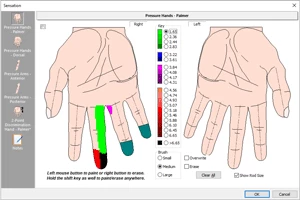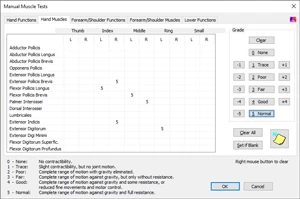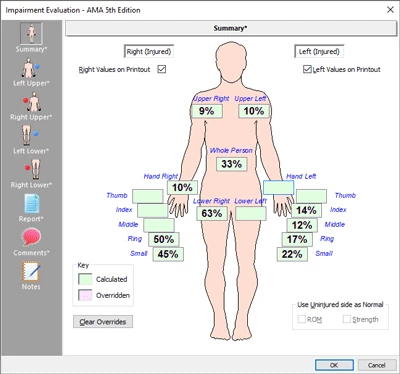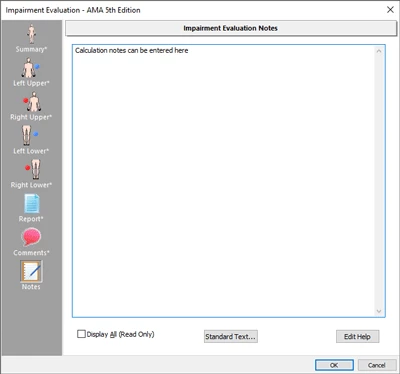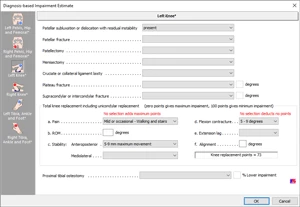Comprehensive Documentation
As well as generating progress reports for grip, pinch and ROM, E-LINK software incorporates additional modules for entering other data in a standardized format. Thus comprehensive reports can be systematically brought together in a time efficient manner. Reports include automatic impairment calculations and can be used for both clinical and medico-legal reasons.
E-LINK ESW Upper Extremity Evaluation Software
This module contains tests to document manually collected data for the upper extremity in a standardized format.
The test sequence lists all available tests in the system and permits the clinician to set up several sequences of tests to be considered for a determined clinical protocol. The clinician can then move through each screen in a consistent manner and enter the appropriate data where needed.
The test screens include:
Amputation (1/10)

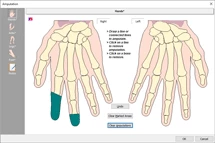
Graphically documents amputations for the hands and/or arms.
- Simply draw a line across the area
- These test results factor into the impairment calculation
- Additional notes may be entered in the notepad
Coverage / Cosmesis (2/10)
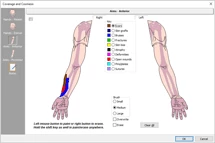
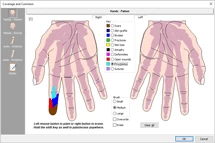
Graphically documents the physical appearance of the dorsal/palmar side of the hand and/or anterior/posterior side of the arm.
- Color coded key chart included for scars, skin grafts, bruises, fractures, skin loss, atrophy, deformities, open wounds, pins/plates and sutures
- Additional notes may be entered in the notepad
Sensation Tests (3/10)
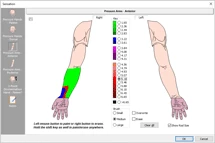
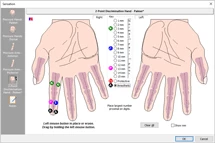
Graphically documents the results from using the Semmes Weinstein static touch pressure test for the dorsal/palmar side of the hand and/or anterior/posterior side of the arm.
- The colour coded key chart may be set for using either a 5 or 20 rod set
Also graphically documents the results from using a Two Point Discrimination Test for the palmar side of the hand.
- Option is included to document the millimetre size or whether the area tested has normal, fair, poor, protective or anesthethic sensation
- The 2PD Test factors into the impairment calculation
- Additional notes may be entered in the notepad
Pain (4/10)

This screen simply permits the level of pain to be documented on a linear scale (0-10).
- The site of pain and side may be noted for 4 areas
- Additional notes may be entered
Edema (5/10)

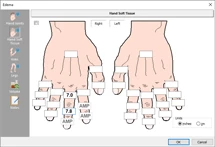
Documents manually entered data for circumferential measurements of edema on the hand joints or over the soft tissue between the joints and for the arm. Also includes option to document measurements of edema using a volumeter.
- Option to enter circumferential readings in inches or centimetres
- Option to enter volumetric readings in US fluid ounces or millilitres
- Additional notes may be entered in the notepad
Manual Muscle Test (6/10)
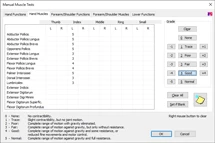
Test data for hand functions, hand muscles, forearm/shoulder functions and forearm/shoulder muscles can be manually documented using the Oxford scale.
- Key for the Oxford scale included
- These test results factor into the impairment calculation
- Additional notes may be entered in the notepad
Dexterity and Provocative Diagnostic Tests (7/10)
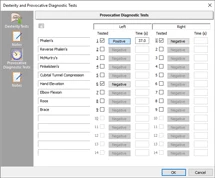
Two screens are included to manually document the results of tests undertaken.
Dexterity tests - for example, 9 Hole Peg Test
Provocative Diagnostic Tests – for example, Phalen’s Test
- These screens may be customized to add a further five test titles into the software
- Additional notes may be entered in the notepad
Outcome Measures (8/10)
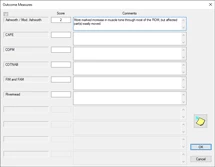
This screen simply permits the results of an Outcome Measure to be entered manually in E-LINK software – for example, COTNAB.
- The screen may be customized to add a further four test titles into the software
- Additional notes may be entered in the notepad
E-LINK ICSW Impairment Calculation Software
E-LINK contains all the tests needed to calculate impairment for the upper extremity based on the American Medical Association (AMA) Guides to the Evaluation of Permanent Impairment (revised 4th and 5th editions) or the Florida Workers Compensation Guide.
All these tests are listed in the test sequence screen and marked with an * asterisk for easy recognition. They may be selected and placed in one sequence so that all the tests may be considered methodically for the impairment calculation.
To obtain a fast, accurate calculation for upper extremity impairment this module is used in conjunction with the E-LINK Hand Kit (Dynamometer and Pinchmeter), the E-LINK ROM Kit (small and large goniometers) and the ESW Upper Extremity Evaluation Software. Extra screens included in this module are those needed to document peripheral nerve disorders and vascular disorders for the impairment calculation.
As the tests are undertaken, the impairment rating is automatically calculated saving substantial time for the clinician over using manual data collection. It also avoids manual calculation errors.
- The impairment calculation can be viewed immediately in the impairment summary screen
- The full report meticulously provides detailed charts and text confirming how the summary values were calculated
- The selected Guides table and page references are included in the detailed text report
- The impairment report also includes the ability to select the uninvolved side as normal values for the calculation of ROM and strength impairments
- The option is available to not print any values for the uninvolved side
- The option is also given to paste these notes into the report
- Additional notes can be entered in the notepad
E-LINK LSW Lower Extremity Evaluation and Impairment Calculation Software
Similar to the ESW Evaluation Software for the upper extremity, this module standardizes data collection for the lower extremity and impairment calculation is also included.
Data collection is enhanced when the E-LINK ROM Kit is used with this module.
The test screens include:
Amputation (1/8)
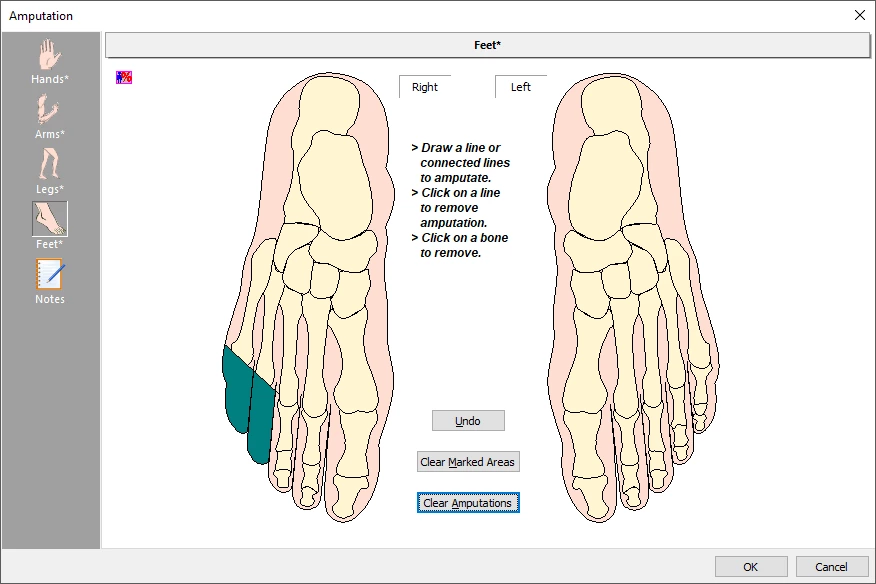
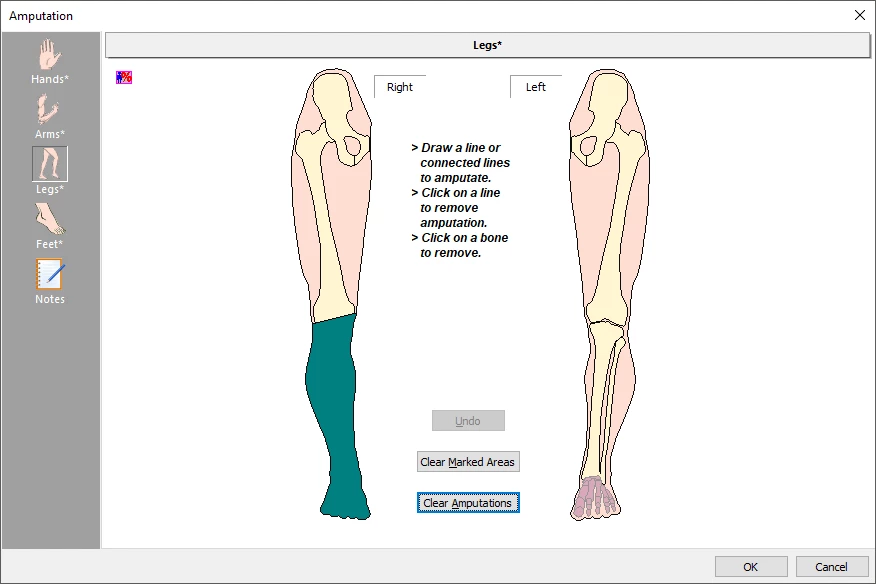
Graphically documents amputations for the legs and/or feet.
- Simply draw a line across the area
- These test results factor into the impairment calculation
- Additional notes may be entered in the notepad
Edema (2/8)
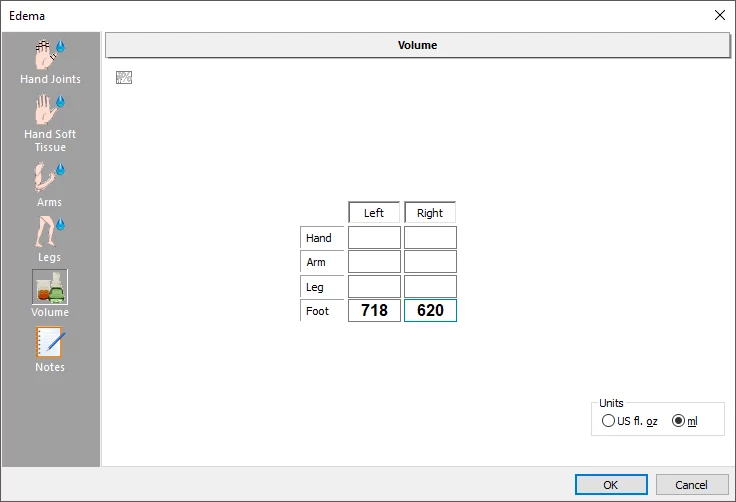

Documents manually entered data for circumferential and volumetric measurements of edema.
- Option to enter circumferential readings in inches or centimetres
- Option to enter volumetric readings in US fluid ounces or millilitres
- Additional notes may be entered in the notepad
Manual Muscle Test (3/8)
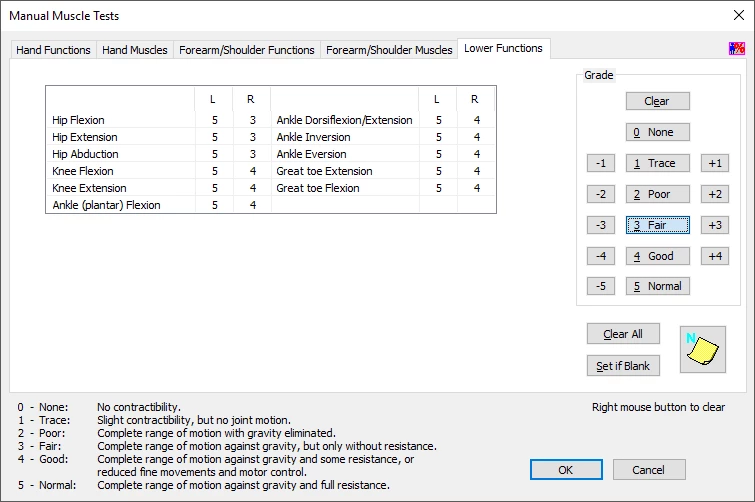
Test data for lower extremity functions can be manually entered using the Oxford scale.
- Key for the Oxford scale included
- These test results factor into the impairment calculation
- Additional notes may be entered in the notepad
Disorders of the Leg (4/8)
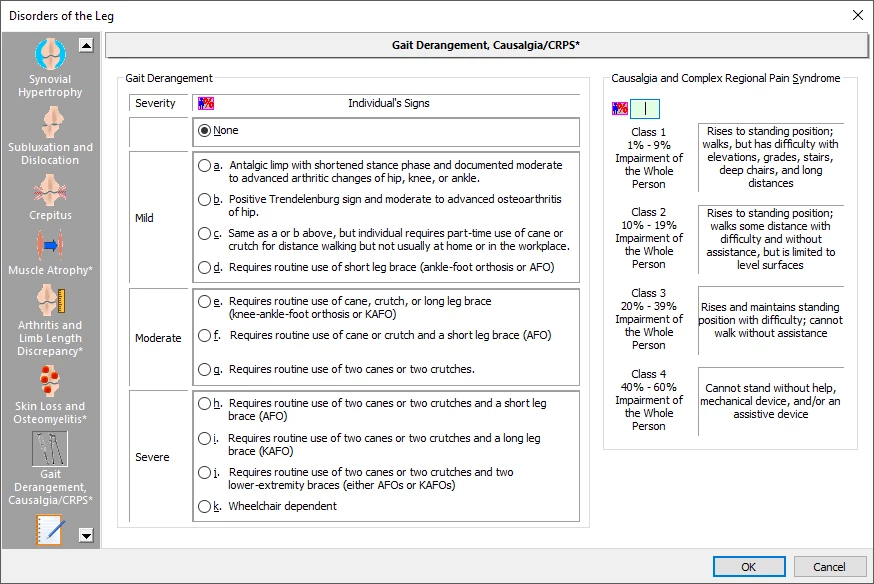

Test results for disorders in the leg may be manually documented and include the following:
- Arthroplasty
- Ligamentous Instability
- Synovial Hypertrophy (example shown)
- Subluxation and Dislocation
- Crepitus
- Arthritis and Leg Length Discrepancy
- Skin Loss and Osteomyelitis
- Gait Derangement, Causalgia/CRPS (example shown)
- Muscle Atrophy
- Results from the latter 4 screens factor into the impairment calculation
- Additional notes may be entered in the notepad
Peripheral Nerve Disorders (5/8)

Data is manually entered for sensory and/or motor loss in the lower extremity.
- These test results factor into the impairment calculation
- Additional notes may be entered in the notepad
Vascular Disorders (6/8)
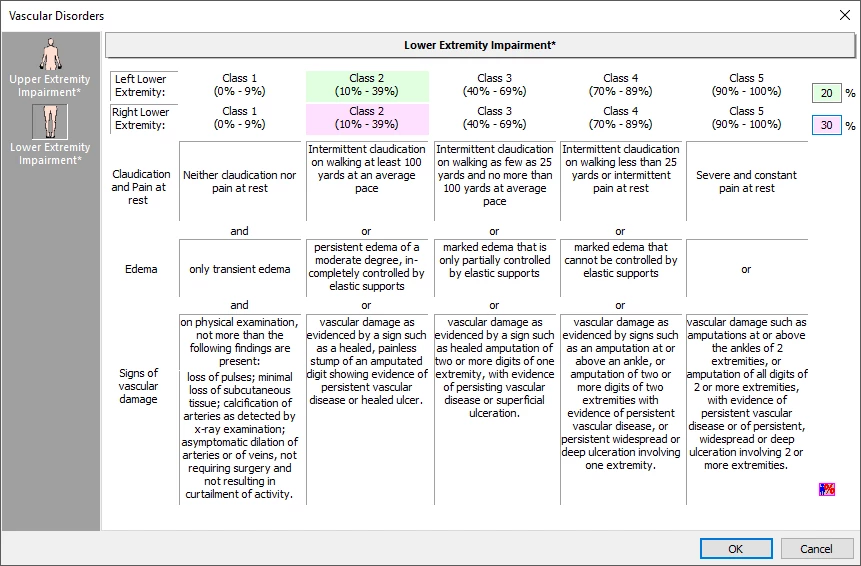
Data is manually entered for the effect of vascular problems on the lower extremity.
- These test results factor into the impairment calculation
Diagnosis-Based Impairment Estimate (7/8)

Some impairment estimates are assigned more appropriately on the basis of a diagnosis than on the basis of findings on physical examination - for example, hip replacement. Data is entered regarding the clinical manifestations and their impact on the ability to perform activities of daily living.
- Results are documented and factor into the impairment calculation
Impairment Calculation (8/8)
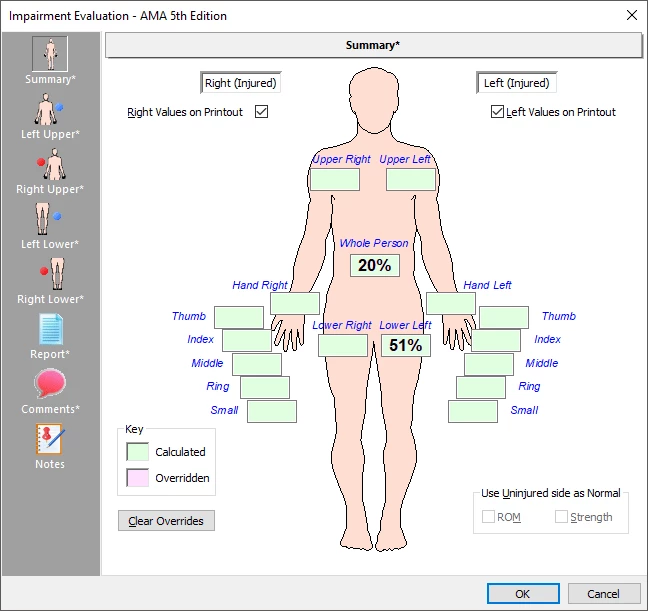
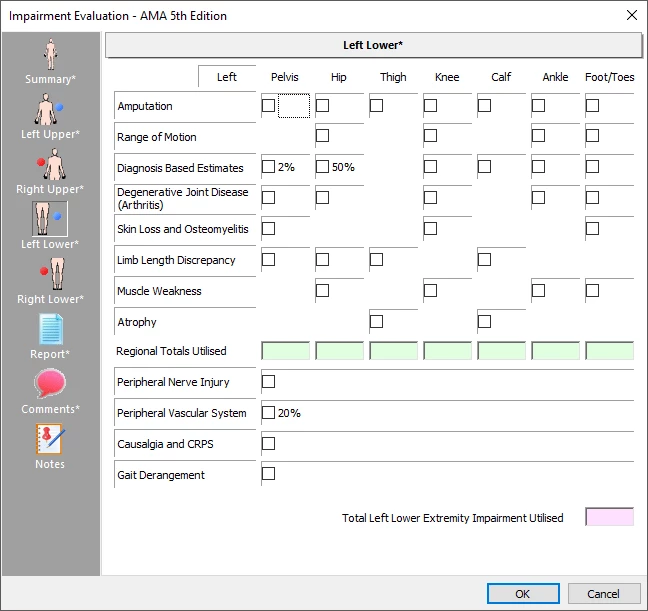
As the tests are undertaken, the impairment rating is automatically calculated saving substantial time for the clinician over using manual data collection while preventing user calculation errors.
E-LINK software gives the option to use the AMA Guides 5th edition, AMA Guides 4th edition or the Florida Workers Compensation Guide.
- Results of the lower extremity impairment calculation are displayed
- Test results which are to be used in the final calculation can be selected
- The final summary chart is displayed and forms part of the report
- The full report comprehensively provides detailed charts and text confirming how the summary values were calculated
- The selected Guides table and page references are included in the detailed text report
- The option is given to paste these notes into the report
- Additional notes can be entered in the notepad

